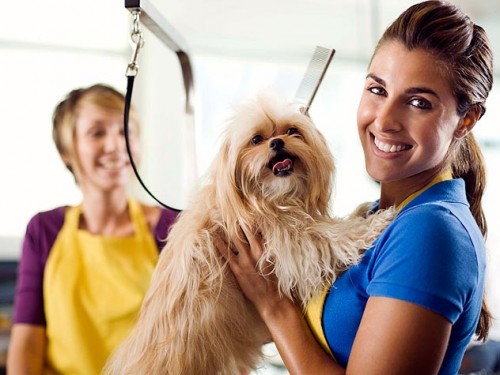Getting Your Dog Used to Being Groomed
Zookeepers are well aware of the value of husbandry training for their animals. Animals in zoos often need to be weighed, have blood drawn, get their nails clipped, and various other maintenance activities. Gone are the days when animals are anesthetized or pressed into squeeze cages for this work. Now trainers teach the animals to stand quietly while their bodies are handled or medicated. Elephants open their mouths to have their teeth inspected, giraffes stand still on a weigh scale, and dolphins swim up and hold out their fins to have blood taken. How do trainers accomplish this? It’s actually quite simple. The animal is taught to climb on the weigh scale or present its ear for the reward of a treat. The behavior is well established without exposing the animal to any unpleasant experiences. An impressive example is the story of a diabetic baboon living in a California zoo. The baboon needed daily insulin shots but he was so aggressive, he had to be sedated each time. This was taking a toll on his health, because of both the sedative and the chronic stress. The zoo brought in animal trainer Gary Priest to see what could be accomplished. Progressing in very small steps, Gary was able to teach the baboon to extend his arm through the bars of the cage and grasp a bar while a technician applied alcohol to his arm, presented a needle, and applied a quick pinch. Eventually, the baboon was happy to go through the whole routine for his favorite reward. Several times a day, the procedure was repeated and, once a day, the baboon was given his insulin. To ensure the baboon’s continued cooperation, the number of mock injections had to be much greater than the number of real injections.

Two or three times a day, play “air” nail clipping. Have your puppy or dog sit and stay. Lift one paw and pretend to clip all the nails but just clip air! Do the same with all four feet. Once a day, clip ONE nail (only if they need it). Intersperse treats throughout. If you do this religiously, your dog will be well mannered and calm during nail clipping. Now, I don’t continue to do this throughout my dog’s life. Once you’ve established a solid foundation, your dog will only need occasional practice.
If your dog is already averse to nail clipping, you’ll have to break the procedure down to miniscule steps. You may have to start by just holding your dog’s paw and touching each nail, with the nail clippers sitting on a nearby table. Treat frequently. Once the dog is comfortable with this, hold the nail clippers in one hand, while holding the dog’s paw with the other. Next, “air clip” only one nail, give an amazing treat, and quit. Resist progressing until the dog is completely comfortable with the step you’re working on. Again, it’s advisable to do this when the dog is sleepy so you’ll meet with less resistance. Be patient – it can take months to reform an intractable nail “clippee”. If all else fails, trot your dog on pavement every day and your nail clipping activities will be restricted to his dewclaws!
Every dog is likely to need medication at some point in his life.
It’s a good idea to accustom your puppy to having his mouth handled so that you can give pills or liquid medicine. For this, I recommend the “baby bird” routine. You’ve probably seen how a baby bird opens its mouth wide to receive a meal from its parent. The baby trusts that food will end up in its mouth. You can teach your puppy to also expect a prize when you open his mouth. Hold the puppy in your lap and place one hand over the top of the puppy’s muzzle. Pry his jaw wide open. With the other hand, pull his bottom jaw down and place a tasty treat on his tongue. Release his mouth. He’ll immediately discover and eat the treat. Make sure you don’t place the treat so far back that the puppy might choke. Repeat numerous times. Pretty soon your puppy will welcome you handling his mouth and, if you occasionally stick a pill inside the treat, your puppy will be unlikely to notice. You may not ever need this training to successfully administer pills but it sure is handy if you have to give liquid medicine or poke around in there to retrieve a chicken bone.
Is there a better way to give pills? Dogs that love food are pretty easy to give pills – just hide the pill in a piece of cheese or wiener and the chowhound is happy to take his medicine. More discriminating dogs chew their food, detect the unwanted pill, and leave it lying on the kitchen floor. For these pill-savvy dogs, here’s a trick that often works. Teach the dog to catch treats tossed to him. Most dogs don’t bother to chew if you get them expecting to catch treats one after the other. On pill days, toss a series of yummy treats, with the pill hidden amongst them. Your dog will never suspect!
Be proactive with your dog. Teach him to enjoy all the things that will inevitably happen to him. He’ll be handled by groomers, poked and prodded by technicians, given needles by veterinarians. You’ll need to check his teeth, inspect his ears and eyes, clip his nails, and give him medication. None of these experiences are naturally pleasant for the dog so teach him to enjoy them. Your dog will be so much easier to care for if you do the foundation work.





